Science
Here's how to see Comet NEOWISE from anywhere this summer – The Weather Network
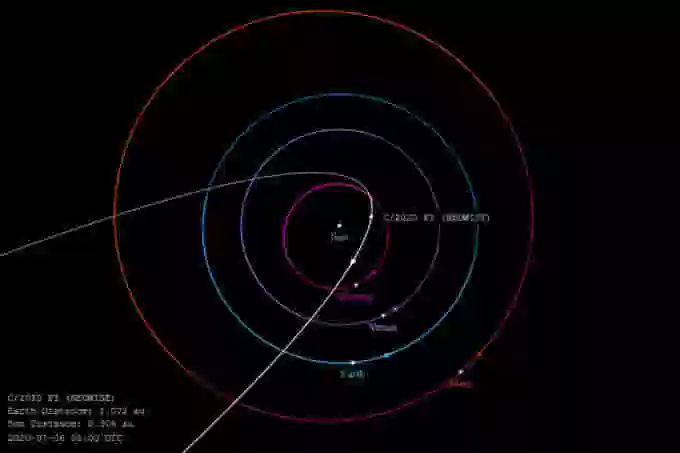

Starting in early July, a new comet showed up in the early morning sky, and it looks like it should remain visible in the evening for the rest of the summer.
Comet C/2020 F3 (NEOWISE) was first discovered on March 27, 2020, as it approached the Sun from below the ecliptic plane. Spotted by NASA’s NEOWISE space telescope, this comet was found to be on a very long journey. It just spent nearly 3,400 years flying in from the outer edges of our solar system to swing around the Sun!
A computer model of the inner solar system shows the path of Comet C/2020 F3 (NEOWISE). Credit: NASA CNEOS
Now having survived that passage, NEOWISE is flying high above the inner planets on its way back to the outer reaches of the solar system.
Ideally located in space to view from Earth’s northern hemisphere, Comet NEOWISE is showing up in the northeastern sky, in the hours just before sunrise.
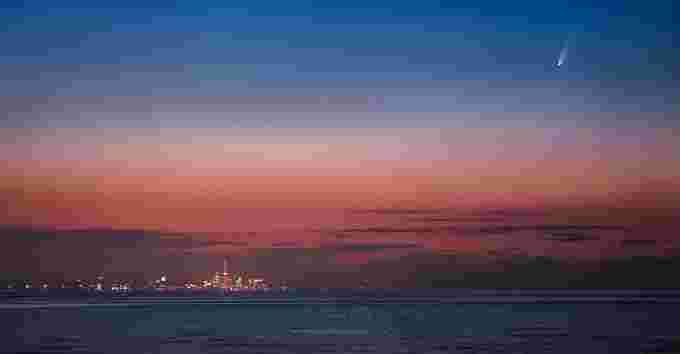

The above image is an idealized view of Comet NEOWISE, of course. According to the astrophotographer who captured it, Weather Network meteorologist Kerry-Ann Lecky Hepburn, the photograph is comprised of several 1-minute exposures. These are all stacked on top of one another using imaging software to enhance the comet’s brightness and bring out more of the details of its tail.
According to the Comet Observation Database, C/2020 F3 (NEOWISE) is estimated at being around magnitude 1.2 right now. That is so-called ‘naked eye’ brightness, and brighter than the stars of the Big Dipper or even Comet Halley during its last pass, back in 1986. Be careful, though. A pinpoint source of light at that brightness, such as a planet or a star, is relatively easy to see, even from light-polluted urban areas. Spotting the diffuse coma and tail of a comet at that brightness is harder, though. This is especially true with light pollution and if the comet is set against the backdrop of a twilit sky.
Responding to a comment on Facebook, Lecky Hepburn said that when she was capturing her long-exposure images, the comet was faint and difficult to see with the unaided eye. She had to use a technique astronomers call ‘averted vision’.
If you have ever spotted something out of the corner of your eye in the night sky, but it vanished when you looked directly at it, you have used averted vision.
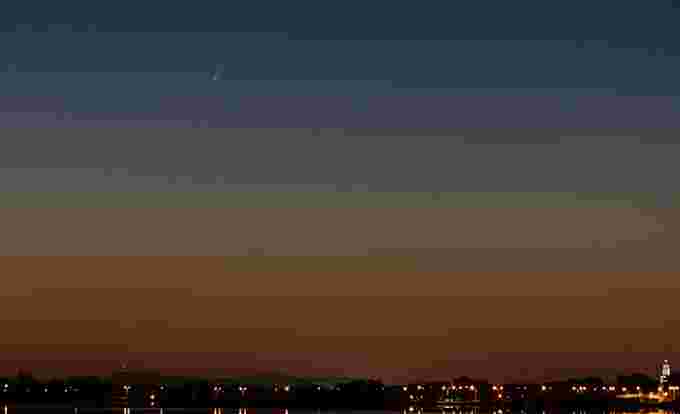

Basically, this technique takes advantage of the sensitivity of our peripheral vision to spot objects too dim to see directly. Its effectiveness can vary from person to person, and you may need to take some time for your eyes to adapt to the dark to get the maximum effect. Still, looking off to one side, while keeping your attention focused on the comet’s location in the sky, may produce results.
For best viewing, seek out a good rural area to watch from, such as the parking lot of a provincial park. If you have a telescope or binoculars, these will make it easier to see the comet, and using averted vision can still help you to hone in on where it is.
MORNING TO EVENING SHIFT
Although visible in the pre-dawn twilight now, Comet NEOWISE will switch things up a bit in the days and weeks to come.
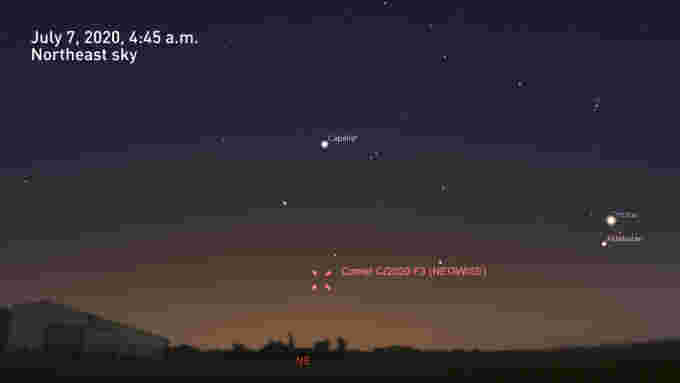

Starting later this week, as the comet continues to swing up over the inner solar system, it will still be visible in the morning. Evening skywatchers, though, should also see it rise above the northwestern horizon after the Sun has gone down.
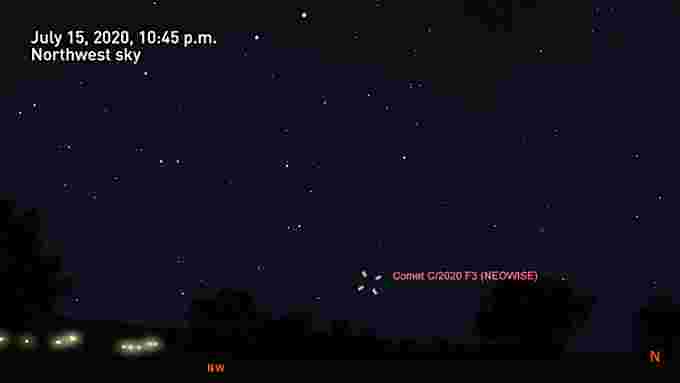

As an evening comet, NEOWISE should be easier to see against the backdrop of the darker sky. Its brightness will still diminish steadily in the next few weeks, however.
Later this month, and into August and September, the comet will leave the morning behind altogether, and remain visible only during the evening, tracking farther into the western sky, night by night.
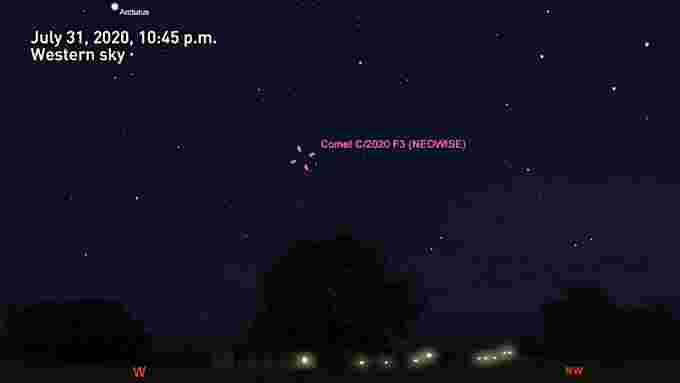

At the same time, its brightness will continue to dim as it moves farther away. So, a telescope or binoculars are still the best way to view NEOWISE throughout the season.
Sources: weatherandsky | Astronomy | Comet Observation Database | With files from The Weather Network
RELATED: WATCH OVER 3 HOURS OF COMET ATLAS IN UNDER 20 SECONDS
Science
NASA confirms mystery object that crashed through roof of Florida home came from space station – Toronto Sun
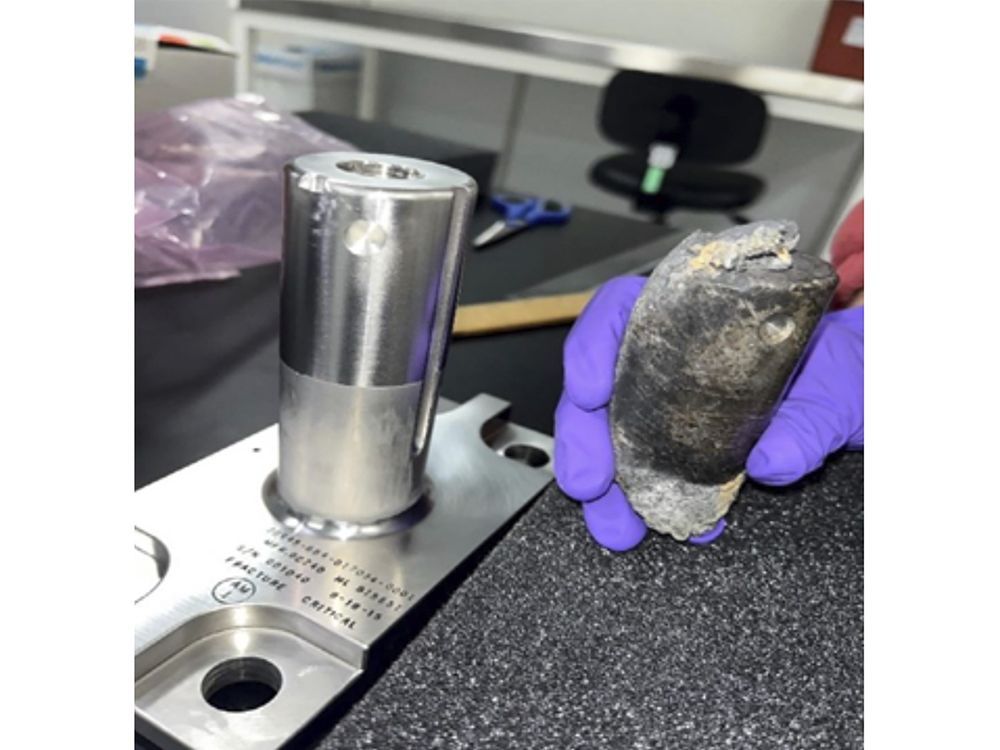

Article content
NAPLES, Fla. (AP) — NASA confirmed Monday that a mystery object that crashed through the roof of a Florida home last month was a chunk of space junk from equipment discarded at the International Space Station.
Article content
The cylindrical object that tore through the home in Naples on March 8 was subsequently taken to the Kennedy Space Center in Cape Canaveral for analysis.
Article content
The space agency said it was a metal support used to mount old batteries on a cargo pallet for disposal. The pallet was jettisoned from the space station in 2021, and the load was expected to eventually fully burn up on entry into Earth’s atmosphere, but one piece survived.
The chunk of metal weighed 1.6 pounds (0.7 kilograms) and was 4 inches (10 centimetres) tall and roughly 1 1/2 inches (4 centimetres) wide.
Homeowner Alejandro Otero told television station WINK at the time that he was on vacation when his son told him what had happened. Otero came home early to check on the house, finding the object had ripped through his ceiling and torn up the flooring.
“I was shaking. I was completely in disbelief. What are the chances of something landing on my house with such force to cause so much damage,” Otero said. “I’m super grateful that nobody got hurt.”
Share this article in your social network
Science
Total solar eclipse: Continent watches in wonder – Yahoo News Canada
Across Mexico, the US and Canada, inside a ribbon of land stretching 155 miles wide but more than 4,000 miles long, tens of millions of people craned their necks, tilted their heads to the sky and watched in wonder as the day turned to night.
What many saw on Monday was a phenomenon like no other: the Moon moving between the Earth and the Sun, extinguishing its light in a total solar eclipse.
The path of totality spanned the continent, beginning over the warm sands of a Mexican beach town and darkening the skies above the crashing waters of Niagara Falls before ending its journey on the shores of Canada’s Newfoundland.
It left a sense of awe in its wake, a reminder of our planet’s place in the universe.
The eclipse was first seen around Mazatlán, Mexico, on the country’s western shores at 11:07 local time (18:07 GMT).
At first, the Moon’s outer edge seemed to just be touching the Sun. Then it devoured more and more until cheers erupted as all finally went dark – save for the silvery glow of the “corona” effect of the Sun around the Moon’s outline.
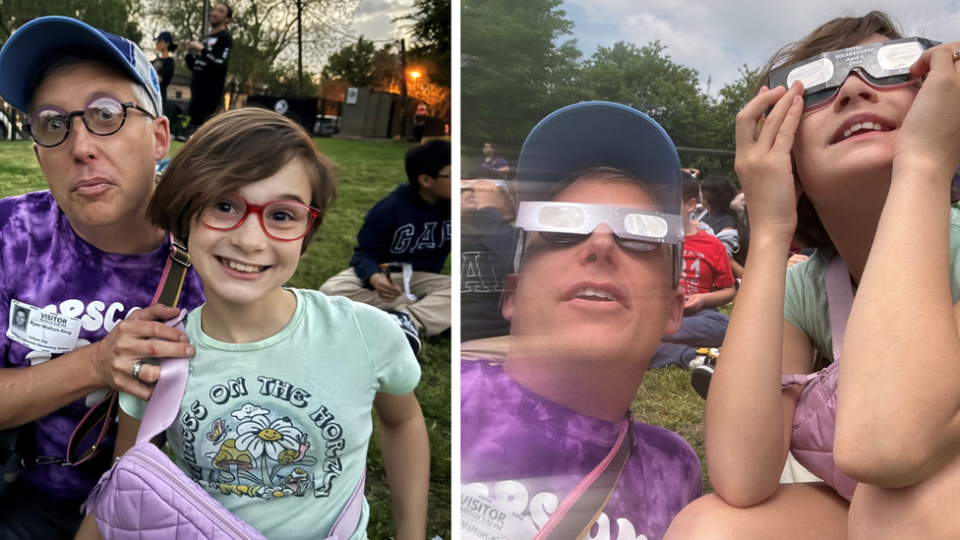
A thousand miles away in Dallas, Texas, 11-year-old Ady Walton-King was waiting, weeks of pent-up excitement ready to burst.
She had learned all about the eclipse in her fifth-grade class at Dallas Academy and on Monday morning she laced up her shoes and tucked four pairs of eclipse glasses into her pink purse – one for herself, one for each parent and one for her little sister, Abigail.
Just before it started, Ady sat down beside her dad, Ryan, on a school field in central Dallas and lifted her gaze upward.
And then it happened.
It all felt slow, she said, as she described the Texas afternoon turning dark. “It looked like the Moon was biting the Sun, but without the teeth marks.”
Clouds slid in and out, occasionally blocking the eclipse from view until the Sun had vanished, nothing left but little flares of light around the Moon.
“I didn’t think it would be like that,” Ady said. “It was really dark out. I thought it would be like evening dark, but it was pretty close to pitch black.”
The temperature dropped suddenly and, just as she had been taught, animals fell silent.
“As it started to get lighter the crickets were there, and the birds started singing. It was really crazy,” she said. “I’m sad it’s over.”
From there, the eclipse moved on, carving its path north-east through the United States.
For some, the solar phenomenon was marked by a personal milestone, with hundreds of Americans joining one of several mass wedding events dotted across the path of totality.


In Russellville, Arkansas, 300 couples from across the country signed up, saying “I do” just before the sky went black. As the sky brightened, the group cut wedding cakes and danced – all part of the aptly named Total Eclipse of the Heart festival.
Following the Moon one state over, in Ellsinore, Missouri, was amateur astronomer Darcy Howard, who had driven from her home in central Arkansas to be sure bad weather didn’t block her view.
She had seen many eclipses before today, two totals, one annular and two partials. “Each one has its own fingerprint,” she said.
Totality today, at around 13:56 local time (18:56 GMT) brought an “eerie twilight”, Ms Howard said, with dusky colours dotted all along the horizon. The corona was nearly as bright as a full moon. “The sense of other-worldliness was all around,” she said.
The 70-year-old has loved the cosmos since her childhood, since her father showed her the Big Dipper, the North Star and the Milky Way, and bought her her first telescope.
“I was hooked,” she said. “I can look through a telescope and see Jupiter… I can see Saturn. And when I see that in space, I know all is right with the world.”


By 15:13 local time (20:13 GMT), the total eclipse had plunged the midwestern state of Ohio into darkness.
In Cleveland, where eclipse-watchers were graced by clear skies, the Sun’s corona was clearly visible, a brilliant halo framing the Moon.
The stars came out in the middle of the day, a sight met with cheers and fireworks, a mid-April New Years Eve.
Many big American cities were not lucky enough to be on the path of totality – but the spectacles were still awe-inspiring. In New York, hundreds of people crowded on to the viewing platform of the Edge skyscraper in Manhattan to see what they could see.
They did not leave disappointed as the sun shrank to a crescent-like sliver of light that cast an unearthly pale gloom over the city.


Tourists had crowded along both sides of the border at Niagara Falls, where the eclipse path crossed from the US into Canada.
Here, the weather offered a formidable challenge, with thick grey clouds mostly obscuring the sky from view.
But just in time for totality – to the audible delight of the crowd – the clouds parted to reveal the black-hole Sun.
Nearby, on a Niagara City Cruise, 309 people celebrated by record-breaking – dressing up as the Sun to break the Guinness World Record for “Largest gathering of people dressed as the Sun”.
The relentless motion of the heavenly bodies meant that the phenomenon did not last long, and it was Montreal that next got its chance to be plunged into temporary night.
In Montreal, 20,000 people crowded onto a field on McGill University’s campus for an event held by the school’s Trottier Space Institute.
“We had been expecting 8,000,” programme administrator Caroina Cruz-Vinaccia said after. The weather was perfect, clear and bright skies. At the moment of totality, the crowd erupted at once, she said.
“I still can’t quite find the words for how cool this was,” she said. “We’re still coming down.”
Crowds were smaller on Newfoundland’s Fogo Island, on Canada’s east coast – one of the last places the totality could be viewed.
Bethany Downery, a Newfoundland native who works for the European Space Agency, tuned into the spectacular view from the Fogo Island Inn, nestled right against the Atlantic Ocean.
The skies were overcast, she said, but the clouds moved miraculously in time to catch near totality.
And with that, a day of collective wonder and celebration reached its conclusion. But it had left a permanent mark on many of those who had witnessed it.
In Dallas, a few thousand miles back along the path, Ady Walton-King was making plans.
Texas will not be in the path of totality again for another 300 years, so she’ll have to travel for the next one in North America, in 2044.
And by that time, she’ll be even more of an expert on total eclipses. “I want to be a scientist by the time that happens,” she said.
– With additional reporting from Brandon Livesay, Nada Tawfik, Nadine Yousif and Helena Humphrey


More on the solar eclipse
Science
Sour gas additive found in Alberta's groundwater – CTV News Calgary


A compound used to treat sour gas that’s been linked to fertility issues in cattle has been found throughout groundwater in the Prairies, according to a new study.
Scientists at the University of Guelph and University of Saskatchewan have identified “large contaminant plumes” of sulfolane, particularly in Alberta.
Dr. Erica Pensini, associate professor at Guelph’s school of engineering, says researchers are tracking how it is spreading in groundwater, work that could help identify risks to supplies of potable water.
She says the study suggests that naturally-occurring sulfates (salts) react with sulfolane in groundwater and its ability to “mix more thoroughly with water.”
“Sulfolane plumes travel faster with fewer sulfates, so we’re trying to clarify migration in the context of what can we do to tackle this contamination,” said Pensini in a news release.
“We’re also partnering up with hydrogeologists and eco-toxicologists to explore other aspects that we’re not directly exploring in our lab,” said Pensini.
What is sulfolane?
Sulfolane, introduced to the market in 1944 by Shell Oil, is “widely used” to remove hydrogen sulfide – a process better known as ‘sweetening’ – from sour gas at thousands of sites across Alberta.
Sulfolane is virtually invisible and doesn’t have a particularly strong smell, so it is nearly undetectable in bodies of water.
“In most cases, you would not notice its presence,” Pensini told CTV News in a statement.
According to a 2008 report by WorleyParsons Komex for Shell Energy Canada, sulfolane was first detected in groundwater in the 1980s and, in 1994, a monitoring program was put in place.
A regional sulfolane monitoring program, which began in 1998, detected sulfolane in off-site groundwater near Shell’s Waterton facility.
By 2007, Shell began actively working to remove sulfolane, building on a pilot project conducted in 2003 and 2004.
Nevertheless, Pensini says the toxicity of the chemical was not fully understood, so it was improperly disposed of.
“It was therefore released in aquifers by sour gas and sour oil processing plants. There were 5,250 plants in 2007 (in Alberta), based on official sources,” she said.
“Each of these plants could have released different amounts.”
According to the Canadian government, “the toxicological database for sulfolane is limited.”
“Overall, oral exposure to sulfolane in experimental animals was associated with immunological, renal and reproductive and developmental effects,” the government’s website reads.
Health Canada says the compound is not likely to accumulate in the human body, but that more than 0.3 milligrams of sulfolane per litre of drinking water is unacceptable.
“Health Canada establishes screening values for contaminants at the request of federal departments, provinces and territories (jurisdictions). These requests are usually made when there is a concern for human health because the presence of a contaminant is suspected or detected in local source water and that contaminant does not have an established limit in drinking water.”
The agency says there are no regulatory limits for sulfolane in other countries, but sulfolane groundwater contamination did prompt authorities in North Pole, Alaska, to include it in the U.S. National Toxicology Program.
Research into whether or not sulfolane poses a risk to human health is still ongoing, Pensini says, but some companies have already raised concerns.
“For example, Sigma Aldritch, a leading chemical supplier, lists this hazard in their (safety data sheets),” she told CTV News in a statement.
“There is sufficient evidence for its impact on fertility for these to be officially reported.”
Crews working on a decommissioned sour gas well in south Calgary in 2017. (Supplied/AER)
Shell working with University of Guelph
Shell Canada says it is aware of Pensini’s research and has been working with the University of Guelph since 2022.
“Shell believes a collaborative and cooperative approach with academia is key to improve environmental practices,” a Shell spokesperson wrote in an email to CTV News.
Shell, which has operated sour gas wells in the Foothills – Jumping Pound, Caroline and Waterton – for 70 years, says it has also worked with the Alberta Energy Regulator (AER) as well as stakeholders and landholders for the past 10 years.
In 2019, Shell sold those sour gas wells to Pieridae, but it is still responsible for “managing and remediating any impacts at the Waterton and Jumping Pound gas plants.”
Shell Canada did not admit that sulfolane poses a risk to human health, but said its work with the University of Guelph “is an important step in advancing the science.”
Rules in place for companies
According to the AER, the body that monitors companies in Alberta’s energy sector, there are 27,562 active sour gas wells in the province, a figure that does not include inactive, abandoned and reclaimed wells.
Many more are scheduled to be drilled, the AER said in a statement to CTV News.
In addition to other regulations, the agency says all facilities that process sour gas require approval under Alberta’s Environmental Protection and Enhancement Act (EPEA).
Contamination still present in Alberta groundwater
Pensini acknowledged that “practices have changed” when it comes to the handling of sulfolane.
“New sulfolane contamination is most probably less significant,” she said. “Filters contaminated with sulfolane are no longer being washed directly into aquifers.”
However, she adds that several decades’ worth of contamination is still present in Alberta’s groundwater.
Pensini says Canadian Light Source, a national research facility at the University of Saskatchewan, has been “instrumental” in understanding the spread of sulfolane.
“We can probe aspects that we couldn’t probe anywhere else, so it is really, really important to us for this research,” she said.
The team’s findings have been published in the journal Physics of Fluids.
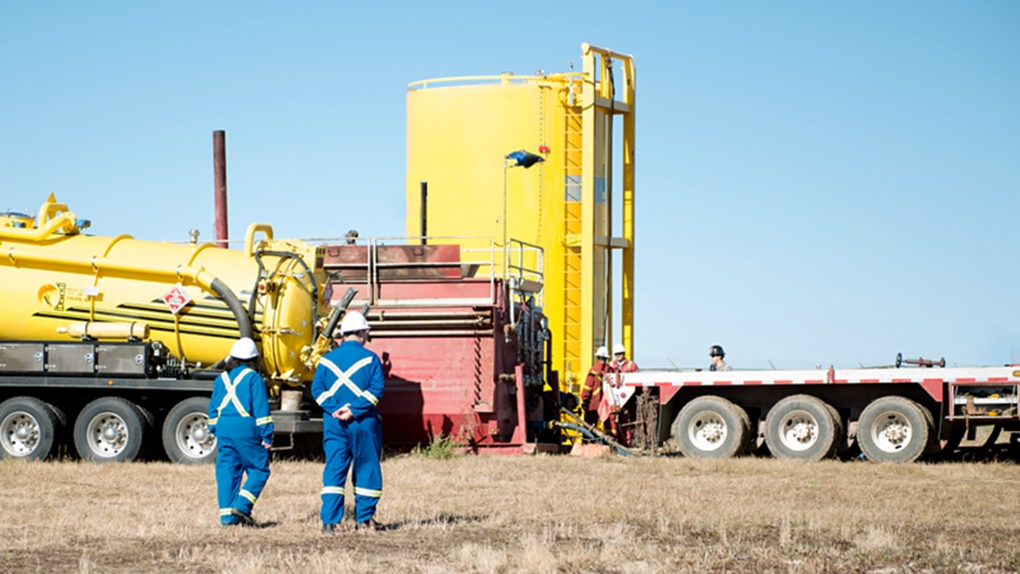

The Alberta government says it’s aware of the study.
“Provincial groundwater monitoring has not detected any notable increases in sulfolane levels in groundwater,” said Ryan Fournier, press secretary for Environment Minister Rebecca Schulz, in a statement to CTV News.
Fournier says the government will be reviewing the study’s findings.
-
Media13 hours ago
DJT Stock Plunges After Trump Media Files to Issue Shares
-
Business12 hours ago
FFAW, ASP Pleased With Resumption of Crab Fishery – VOCM
-
Media12 hours ago
Marjorie Taylor Greene won’t say what happened to her Trump Media stock
-



 Tech21 hours ago
Tech21 hours agoHow funny? Australian researchers use AI to generate cartoon captions – Digital Journal
-
Business13 hours ago
Javier Blas 10 Things Oil Traders Need to Know About Iran's Attack on Israel – OilPrice.com
-
Media11 hours ago
Trump Media stock slides again to bring it nearly 60% below its peak as euphoria fades – National Post
-
News23 hours ago
Anyone want a camper? It's a buyer's market for RVs as pandemic-era sales fizzle – CBC.ca
-



 Sports24 hours ago
Sports24 hours agoSerdachny scores overtime winner as Canada edges U.S. for women's hockey worlds gold – CBC Sports







